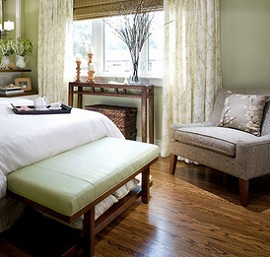
When homeowners wish to install hardwood flooring in their homes, they oftentimes are faced with the problem of temperature and humidity. When substitutes such as laminate flooring or vinyl flooring won’t do, engineered hardwood floors can be an excellent solution.
Why Engineered Wood Flooring? Engineered wood is generally preferred over solid hardwood when flooring is required in any area where changes in humidity and temperature vary. It is much more resistant to temperature changes than solid wood. When an installation is below grade, or over or near radiant heating systems and/or any humid area or climate is concerned, engineered wood is firmly favored over solid hardwood, the use of the latter being discouraged by most professionals.
Engineering Engineered Wood Flooring: Engineered wood is designed to provide better stability and resistance when moisture or heat may cause problems for solid wood floors. Engineered floors feature a multiple-ply plank design , meant to allow for expansion while maintaining its structural stability. This flooring is made up of an inner core of hardwood and/or softwood plywood or high density fiberboard and a top layer of veneer that is glued on the top surface of the core. These layers are bonded together under heat and pressure. How Engineered Wood Flooring Works The stacking of the layers is meant to prevent the natural tendency of hardwoods to expand, contract, warp, or cup when exposed to different environmental factors, especially when moisture causes solid hardwood floors to expand excessively. As a result, engineered floors counteract twisting and warping in presence of moisture, and remain flat and intact. This design is what makes it possible for homeowners to install wood flooring, albeit a highly modified version of the same, as kitchen, bathroom, and basement floors.
This ‘multiple-ply plank’ feature also makes engineered wood an excellent alternative in geographical areas that have excessive humidity, or in building spaces otherwise unsuited for solid. Similarly, engineered flooring is a versatile choice in flooring, resistant to heat as well moisture. Engineered flooring is a logical alternative to solid wood in areas where environmental factors do not allow solid hardwood floors to flourish.
Applications for Engineered Wood Flooring Aside from its ability to withstand moisture, engineered wood flooring is also much more resilient against fluctuations in temperature. For that reason, it is one of the few recommended flooring materials for use under radiant heating systems. The only other flooring materials that are able to withstand this heated application are stone flooring and some laminate flooring. Since radiant heating systems are excellent for comfort and reducing overall energy expenses, it’s good to know that there is a wood flooring material that can take the heat.
Engineered Wood Floors for Your Home Ultimately, what it comes down to in simplest terms is if you want real wood floors in high moisture environments, your only viable option is engineered hardwood flooring. You may be able to seal wood against moisture, but sealing it against temperature changes is simply impossible. However, since engineered wood floors are made from real wood strips, the only way anyone will be able to tell the difference is if you let them in on it. And that, friend, is entirely at your discretion.





